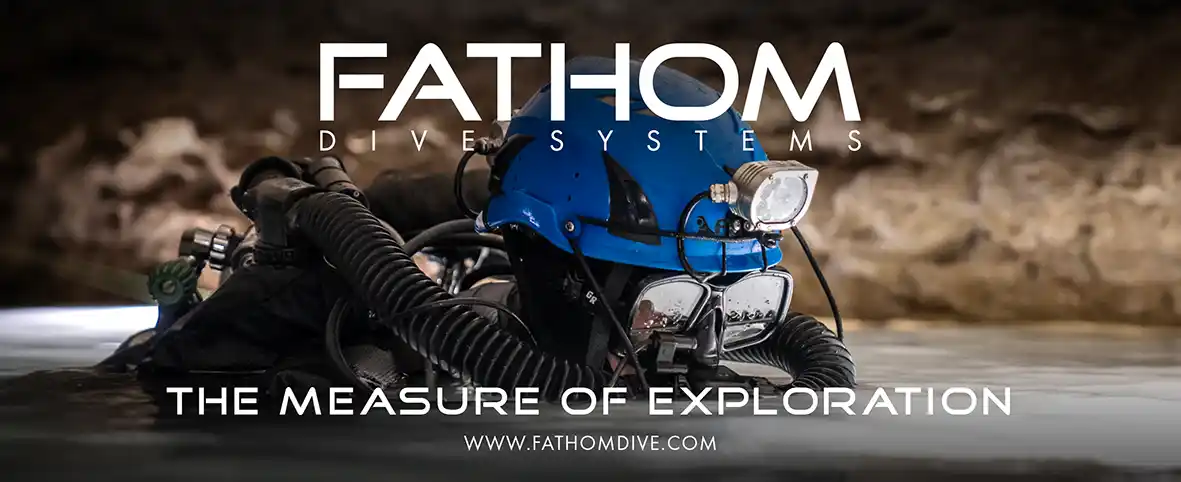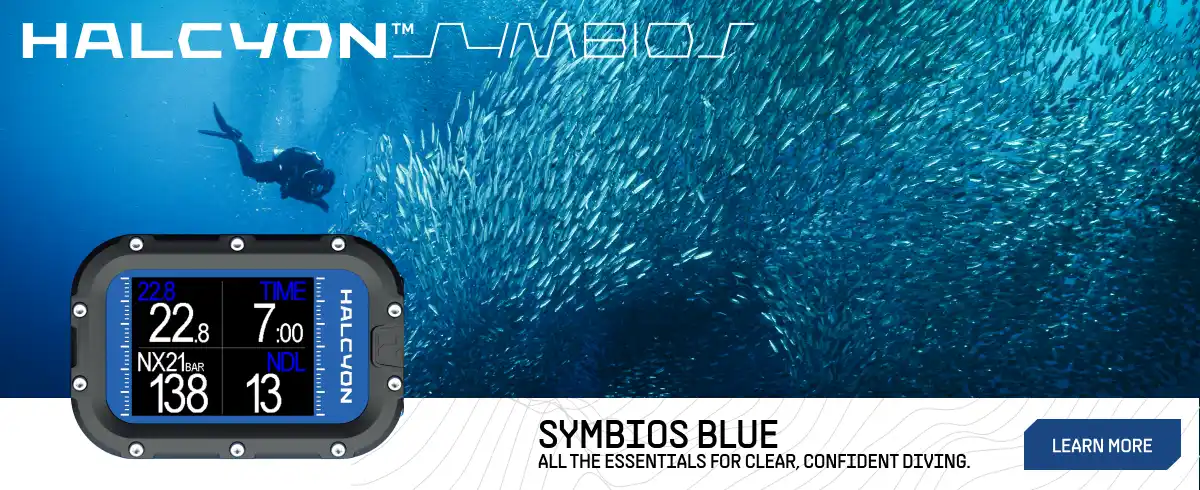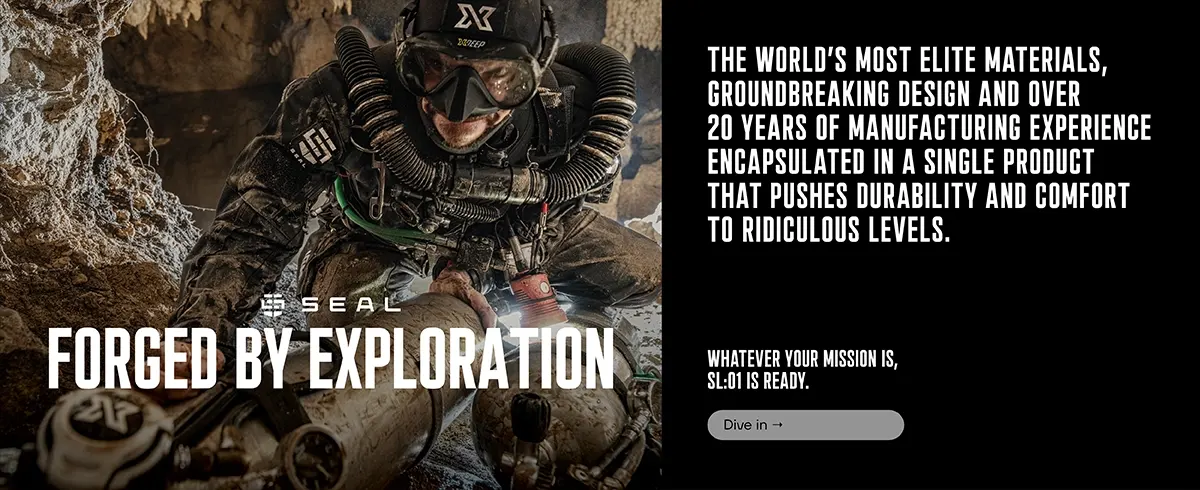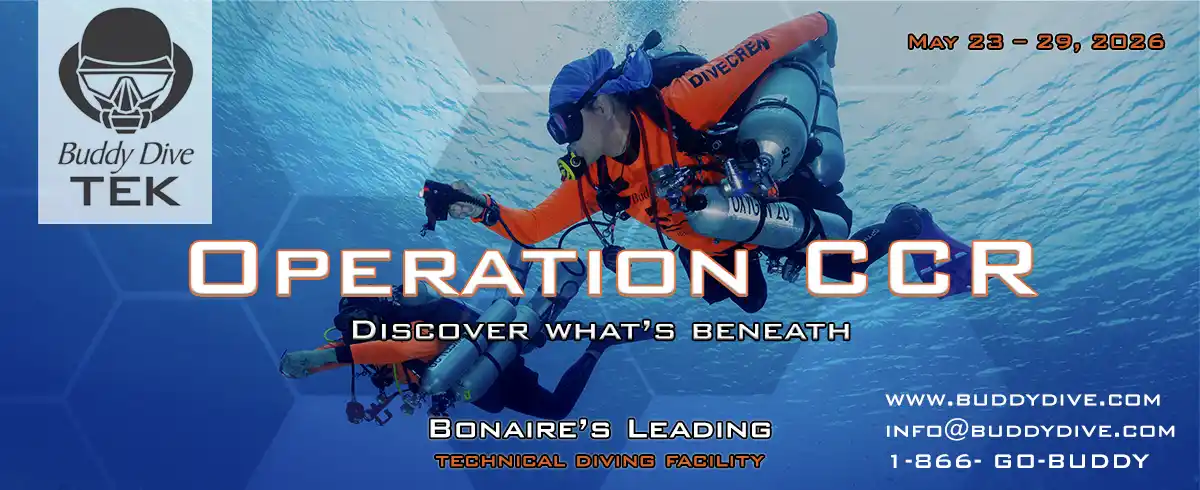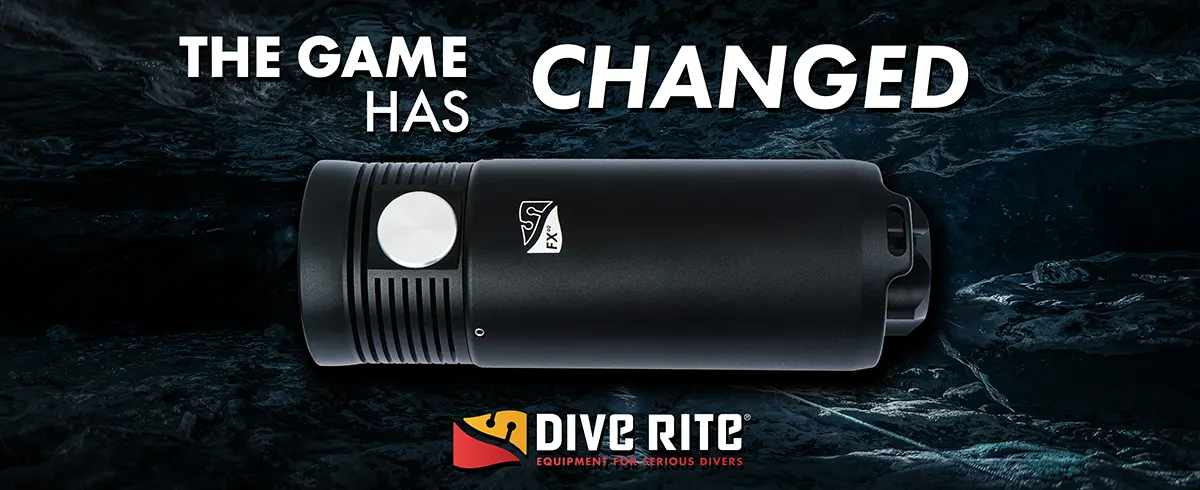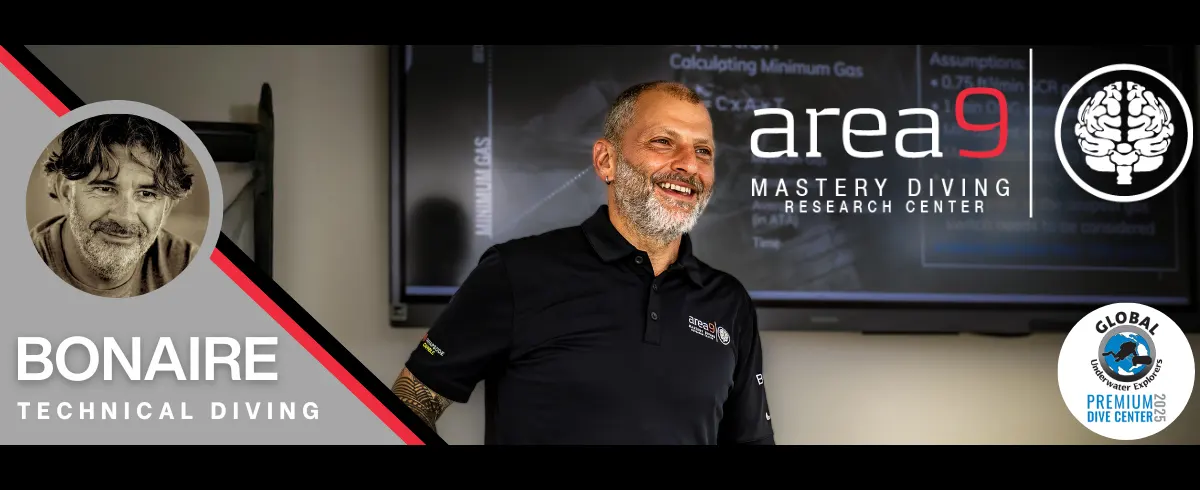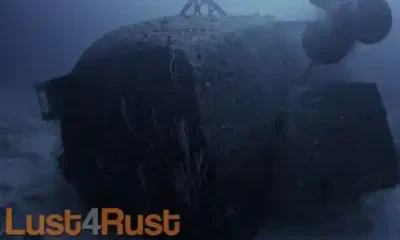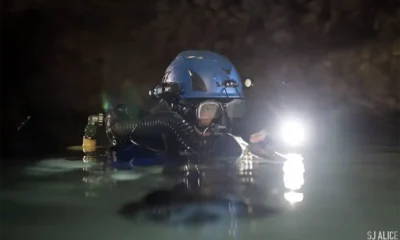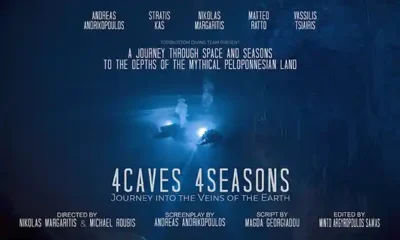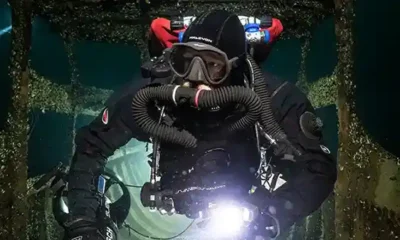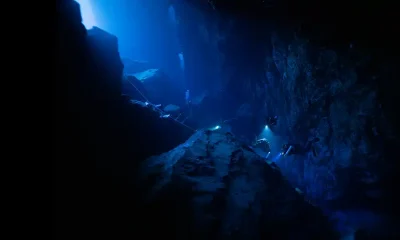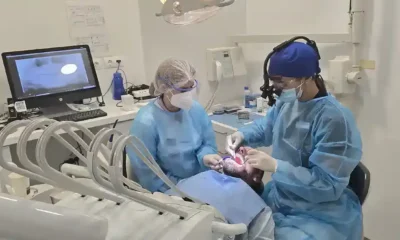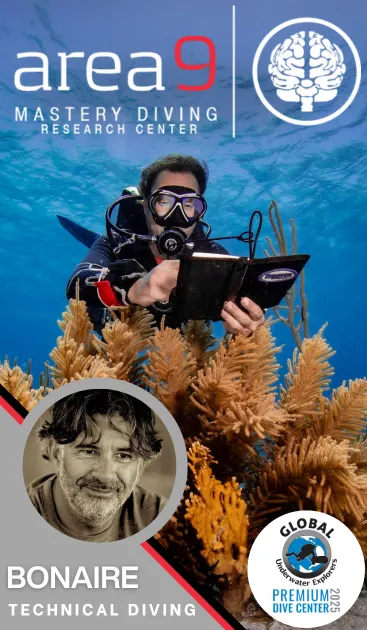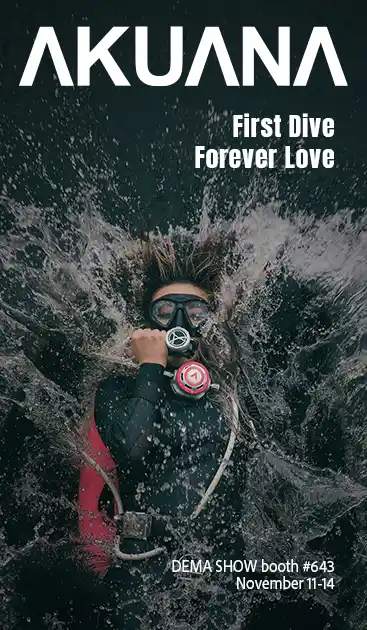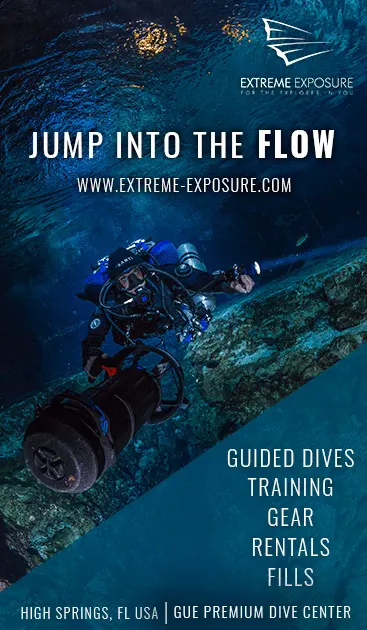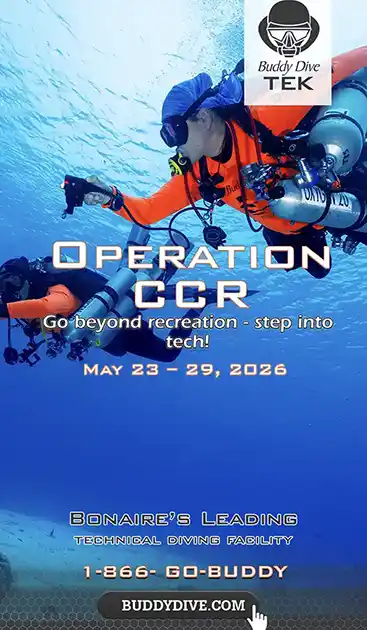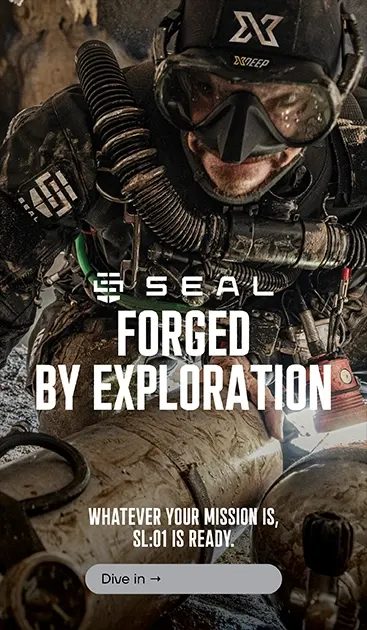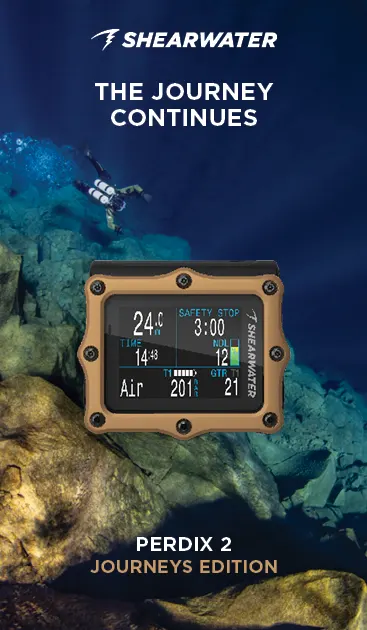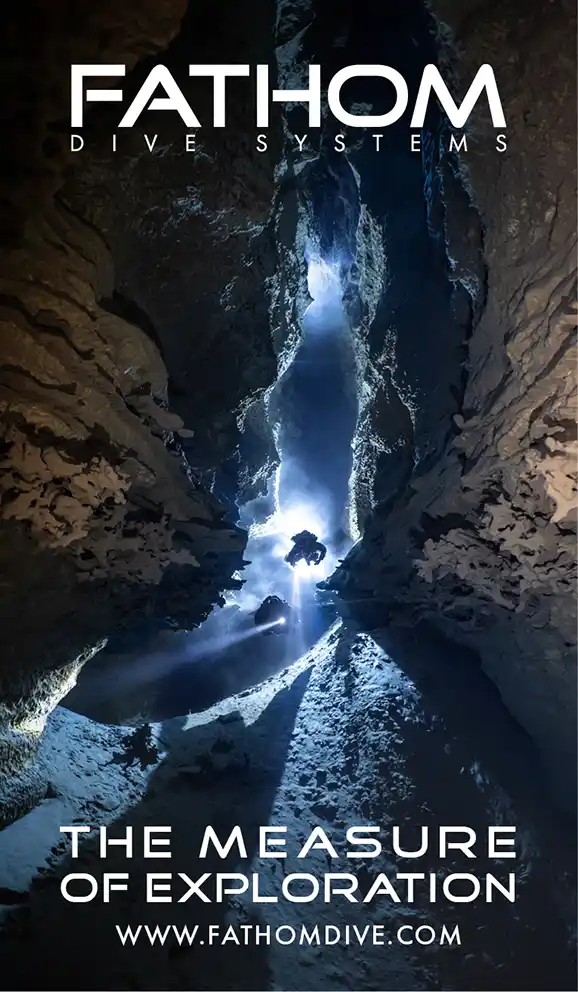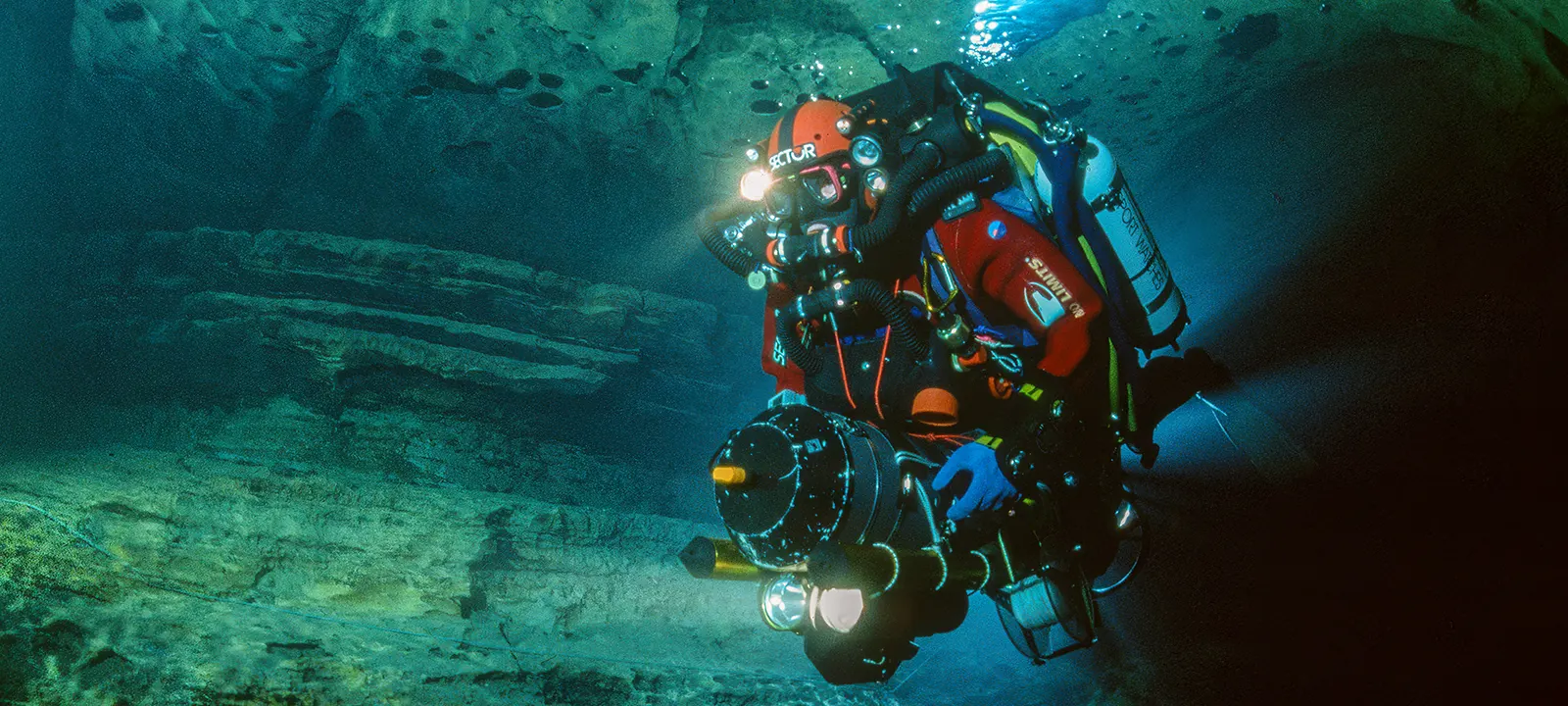
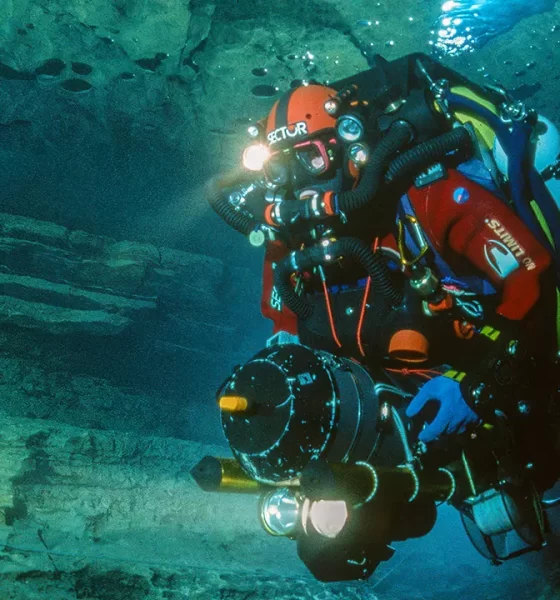
Latest Features
Do it Redundant
For the 70th Anniversary of the French Navy’s successful DC55 semi-closed rebreather (SCR), retired Swiss cave explorer and pioneer Olivier Isler reviews the contributions of the first semi-closed rebreathers on early cave exploration, specifically Jochen Hasenmayer’s STR80, Isler’s own RI 2000, and later the RB 80, and the closed circuit units that followed. These led to the irreversible evolution towards fully redundant rebreathers for cave diving, which Olivier helped pioneer. Are you ready for a deep dive into history?
Text and images by Olivier Isler. Lead image: Isler diving the redundant RI 2000 in Doux de Coly, France.
Reflections on the Evolution of Cave Diving with Rebreathers
Cliquez ici pour la version française
The year 2025 is a landmark in the history of diving development, marking the 70th anniversary of the DC 55 rebreather, used from its inception by the French Navy.
Jean Dufau-Casanabe was the brilliant inventor behind the concept of this semi-closed proportional-leak rebreather (passive addition). He worked as a chemist and pharmacist at the GERS (Underwater Study and Research Group) in Toulon, the Mediterranean base of the French Navy.
This remarkable researcher probably had no idea at the time that his invention would have such a major impact on the evolution of cave diving. As someone who was directly involved, I will now recount this long and obstacle-filled journey, referring occasionally to Tim Blömeke’s excellent article on using dual rebreathers.
A Bit of History
Looking back, it is now obvious that the advent of rebreathers in cave diving was inevitable, if only due to the distances and depths being reached. Another reason, rarely mentioned, was the “correction of physiological inequalities.” In open circuit, a diver with a large build was disadvantaged due to increased gas consumption—an issue largely offset by the significant efficiency gains brought by rebreather technology.

The STR 80: A Forerunner
The first to take an interest in the concept of redundancy was the famous German diver Jochen Hasenmayer, a pioneer of cave diving in Europe. In 1980, he developed an intriguing concept named STR 80 (Speleo Twin Rebreather). Very secretive, Hasenmayer seemingly never provided a detailed description of its workings. Only one testimony appears in The Darkness Beckons (see references at the end of the article). His device was composed of two closed circuits, each with 24 hours of autonomy! A single O₂ sensor (not very reliable at the time) per circuit could be compensated by a switch to semi-closed mode in case of issues. As a last resort, open circuit was an option.
While promising, the system may have been too complex. Using open circuit as a backup for a unit designed to sustain two days of diving seems excessive, especially in the event of a serious incident far from a sump entrance. The STR 80 underwent several test dives in caves, marked by several incidents (which is to be expected for a prototype), according to a friend who assisted on some dives. Reliable records of actual exploration achievements are lacking. The Darkness Beckons mentions a dive extending the Landenouse spring exploration from 90 m/295 ft to 88 m/289 ft depth at 1,240 m/4,068 ft penetration. A notable dive at the Ressel (a famous French sump) is also reported, though this is contradicted by Hasenmayer’s own account, in which he clearly states using open circuit. The mystery remains…
Was this concept too far ahead of its time? Or did Hasenmayer himself have doubts about his device’s reliability? This seems plausible, given that he performed his most significant dives (Ressel in 1981 and Fontaine de Vaucluse in 1983, reaching 205 m/673 ft) using high-capacity open circuit setups. Despite its innovation, the STR 80 did not enable major exploratory breakthroughs. Nevertheless, it remains an indisputable precursor.
The RI 2000 – Genesis of the Rebreather Idea
In 1984, during a Himalayan-style exploration at La Doux de Coly (Dordogne, France), a distance of 3.1 km/1.9 mi was reached. It became obvious that continuing on open circuit would be increasingly difficult. A decision was made to initiate a true technical revolution by switching to rebreathers. This shift was facilitated by meeting Alain Ronjat, a computer engineer who was in contact with Henri Paole, a rebreather specialist at the French company FENZY.
From Idea to Implementation
Desiring simplicity of use and limited by modest means, we opted for a semi-closed system. A problem quickly emerged: How would we adapt the DC 55’s operating principle to cave diving? A lack of confidence in overpressure valves—requiring inspiratory effort and unreliable at the time—led us to design an electromechanical version of the proportional leak.
The only components salvaged from FENZY stock were breathing bags, injectors, valves. Everything else we had to invent. Specs:
- Semi-closed circuit rebreather, adapted for cave diving
- Electromechanical leak detection
- Triple redundancy through 3 independent circuits
- Maximum breathing comfort
- Extended autonomy (approximately 24 hours at 50 m/164 ft depth)
- Safety considered down to the finest details
After 5 years and 5,000 hours of work, the RI 2000 became operational. Everything possible had been done to increase safety—dual injectors, reinforced components, protected breathing bags, and so on.

Some Key Features:
- Front-mounted rebreather with twin canisters (2 × 2.5 kg/5.5 lb of soda lime), easily removable
- Rear view of the dual-circuit version (2 × 3.5 kg/7.7 lb soda lime per canister)
- Double injector system
- Breathing bag with external protection
- Power/gas feed system



Preliminary Testing Before Cave Diving
Twenty-three dives were carried out in a lake down to 50 m/164 ft. The shoulder-level positioning of the bags—close to isobaric with the lungs—offered very comfortable breathing. Despite the overall weight (>90 kg/198 lb), finning speed was satisfactory (22–25 m/72–82 ft per minute).
Depending on the diver’s position, the leak ratio varied slightly: about 1:10 horizontally and 1:7 vertically. The average was approximately 1:9. As an additional safety measure, a four-hour dive was performed simulating complete electronic failure.
In Cave Diving
August 1989 – Doux de Coly
Dive to 2 km/1.24 mi. Several modifications were necessary. Preparation was insufficient for a deep push.
December 31, 1989 – Cogol dei Vecchi, Oliero, Italy
First success: 400 m/1,312 ft line laid. Stop under decompression stop insight of the surface at 2,370 m/7,776 ft from the entrance. No problems encountered.
August 12, 1990 – Ressel
First full traverse in total autonomy. Only staged cylinders: Nitrox at 30 m/100 ft and oxygen at 9 m/29 ft for final deco on the way back. Penetration: 105 m/344 ft. Sump length: 1,850 m/6,070 ft, 81 m/266 ft. Total dive time: 10 h 35 min.

August 12 Dive: Technical Info
- Penetration: 105 m/344 ft
- Sump length: 1,850 m/6,070 ft, 81 m/266 ft
- Decompression duration: 3 h 24 min
- Total dive time: 10 h 35 min
- RI 2000 rebreather. Belly-mounted unit dropped off at 42 m/138 ft (upstream)
- Gas mixtures carried:
- 2 × 20 L + 1 × 12 L Trimix 30 % He – 1 × 12 L Nitrox 48 % O₂ – 2 × 4 L O₂
- Scooter: 1× Aquazepp 714 TS
October 1990 – Cogol dei Vecchi
Traverse of 2,375 m/7,792 ft long and 56 m/184 ft deep.
Doux de Coly 1991
Two autonomous dives. The second was shortened due to a very rare simultaneous failure of both injectors on one breathing bag after a gas mix change.
Despite the incident, the 4 km/2.49 mi barrier was broken in a siphon at an average depth near 50 m/164 ft—an unprecedented milestone in autonomous cave diving with no support cylinders staged.

1991 in Figures
- Dive No. 1: farthest point at 3,840 m/12,598 ft (+740 m/2,427 ft penetration).
Total duration: 12 h 15 min - Dive No. 2: 4,055 m/13,304 ft. Total duration: 13 h 35 min
- Twin super Aquazepp
- RI 2000 with triple redundancy
- Mobile bell from 18 m/59 ft to 6 m/20 ft
- Bottom mix: Trimix 30% He, 25% O₂ – Nitrox 40%
- Deco mixes: Various Nitrox – O₂, from 12 m/40 ft
- Dive tables calculated by Bill Hamilton
Doux de Coly 1997
Six years had passed. A tragic accident involving a friend at the entrance of a Sardinian spring in 1992 had led to a complete reassessment over several years.
The dive was a failure. The line was broken in several places, and the diver’s speed—excessive under poor visibility—led to a collision in which a blade of rock punctured one of the rebreather hoses more than 2 km/1.24 mi from the entrance.
Having a double redundancy system on the return leg validated the RI 2000’s triple redundancy design.
Doux de Coly 1998
A difficult dive requiring significant re-rigging and some new discoveries.
This final dive marked the end of a journey begun 14 years earlier.

Dive of August 2, 1998: Key Figures
- Line laid: 1,150 m/3,773 ft (800 m/2,888 ft re-laid) – 350 m/1,148 ft during first dive
- Final point reached: 4,300 m/14,108 ft
- Bottom time: 5 h 42 min
- Total duration: 16 h 22 min
- Gas consumption (except decompression stops): 4.1 m³ (16.8 L carried)
- Rebreather: RI 2000 (2 × 20 L + 2 × 12 L)
- Gas mixes:
- Bottom: Heliox 25% O₂
- Deco: Heliox (40–70% O₂), O₂
- Tables: saturation tables calculated by COMEX specialist (Jean-Pierre Imbert)
- Scooters: 1 main + 1 tow scooter (limited autonomy)
- Bell: stainless steel frame, flexible shell made of cordura and neoprene

The RI 2000’s Contribution to Cave Diving
Despite a career shortened by the long interruption mentioned above and a usage far below its true potential (as shown by the gas consumption from the 1998 dive : 4,1 m3 used of 16,8 carried), the RI 2000 proved two important points:
For the first time, a rebreather allowed distances to be reached that were out of range for open circuit systems.
The technological revolution—abandoning open circuit in favor of rebreathers—was validated by fully autonomous dives.
This is the enduring legacy of a prototype that opened new horizons.
The RB-80
Designed after the RI 2000, the RB-80 benefited from improved reliability of overpressure valves. Though its appearance is different—housed in a cylindrical case—its fully mechanical operating principle is identical to that of the famous DC 55. David Rhea’s detailed article highlights its success in cave exploration, further emphasized by the newer SIDEMONT version (SIDEMOUNT RBK) whose positioning likely improved breathing comfort.
It’s a notable success that again proves that the brilliant idea developed 70 years ago by Dufau-Casanabe remains entirely relevant today.
Further and Deeper: An Irreversible Evolution Toward Full Redundancy in Rebreathers?
I’ve discussed here the important role played by semi-closed rebreathers in the evolution of cave diving. As dives become both longer and deeper (beyond 100 m/330 ft), managing an ideal PPO₂ becomes critical. Semi-closed systems inevitably give way to closed-circuit units.
Historically, closed-circuit rebreathers—being more complex—came into their own later. Starting with the famous CIS-LUNAR tested by Bill Stone in 1987 at Wakulla, other models progressively gained prominence from the 2000s onward. Here are some examples.
The KISS, used by Rick Stanton, enabled him to surpass many sump termini, often well past 100 m/330 ft depth.
John Vonlanthen used a modified INSPIRATION, as well as the JOKI, a remarkable CCR developed by Frédéric Badier and built in small series. Using this same unit in triplicate for redundancy, Xavier Méniscus completed extreme dives (e.g., 233 m/764 ft depth at 2 km/1.24 mi from the entrance!). More recently, the LIBERTY has also proven its worth—and there are certainly others, as many new models continue to emerge.
A dominant trend today in rebreather design is the SIDEMOUNT version: compact, easy to use, and suitable for redundancy when used in pairs.
Redundancy is becoming essential. Tim Blömeke, in his article, highlighted the near-insurmountable difficulty of ensuring rebreather safety by staging bailout cylinders at long distances. In extreme deep diving, this issue becomes irrelevant. Staging tanks at 200 m/656 ft depth makes no sense—especially considering the short useful time (due to ~300 liters/min at normobaric pressure) and significant time lost during deployment.
And time is now a critical safety factor at such depths.
Two successive extreme dives at the now world-famous Font Estramar aquatic spring (“résurgence” in French) in France dramatically illustrate the validity of redundancy using two identical rebreathers.
November 2023 – Frédérick Swierczynski breaks the mythical 300 m/984 ft barrier, reaching 308 m/1,011 ft depth.
January 2024 – Xavier Méniscus pushes the terminus to 312 m/1,024 ft.

This is no Zacatón or Boesmansgat profile. The terminus lies 1,000 m/3,281 ft from the entrance!
A new problem also arises: not only does the risk assessment model (work/redundant CCRs) fully apply, but so does human risk. Physiologically, neither diver—despite flawless technical execution—emerged incident-free. Frédérick experienced a respiratory issue, and Xavier suffered a vestibular accident treated on-site! Their composure prevented a dangerous outcome.
This is a new type of risk that extreme divers must now accept, with depth quickly becoming a limiting factor.
Conclusion
Long-distance and deep dives carry risks—this is undeniable. Each diver must assess these as best they can. Having long since retired from cave diving, I now follow with admiration the evolution of a discipline that has given me so much—where the path of redundancy, which I pioneered with my prototype, is now continued by the best divers of today. That is a gratifying recognition.
Additional References
The Darkness Beckons: The History and Development of World Cave Diving by Martyn Farr. Vertebrate Publishing, Sheffield 2017
Victory at Last, by O. Isler and John Simenon, DEEPTECH, October 1998
My Journey to 1010 feet / 308 m by Frédérick Swierczynski, Advanced Diver Magazine, November 2023
DIVE DEEPER
aquaCORPS: Measured Elegance by Olivier Isler, aquaCORPS #7 C2 (1994)
InDEPTH: The First Helium-based Mix Dives Conducted by Pre-Tech Explorers (1967-1988) by Chris Werner
InDEPTH: When Easy Doesn’t Do It: Dual Rebreathers in Extended-Range Cave Diving by Tim Blömeke (2022)
InDEPTH: Tech Diving in Pop Culture w/Olivier Isler
InDEPTH: The RB80 Semi-closed Rebreather: A Successful Exploration Tool by David Rhea
InDEPTH: Über-deep with Cave Explorer Xavier Méniscus by Michael Menduno
inDEPTH: Le Grand Bleu Goes Underground
by Cristian Pellegrini
inDEPTH: Omne Trium Perfectum by Axel Schoeller
InDEPTH: The Quest for Symbiosis: Meet Hydrophilis by Olivier Isler

Born in 1950, Olivier Isler is a biology teacher. From age 20, he has been passionate about diving in extreme and challenging environments. He got into cave diving more for the technical challenge of the activity than for the flooded caves themselves. He explored several major cave systems in France, Italy, and the Canary Islands, where he reached the furthest point of the Atlantida Tunnel: the longest underwater lava tube in the world (about 1,500 m/4,921 ft).
Together with a French engineer, he built the RI 2000, the first entirely redundant rebreather. Using this system, he was the first CCR diver to go beyond 4,000 m/2.49 miles on a single dive in 1991. He stopped exploration in 1998 after a difficult sixteen-hour solo cave penetration over 4,300 m/2.67 miles.
Using his 25 years of experience, in 2002, he developed an innovative, low-volume, autonomous diving helmet, the XDH. In 2011, he received the Golden Trident from the International Academy of Underwater Sciences and Technique in Genoa, Italy, celebrating his 30 years of exploration and innovation.

